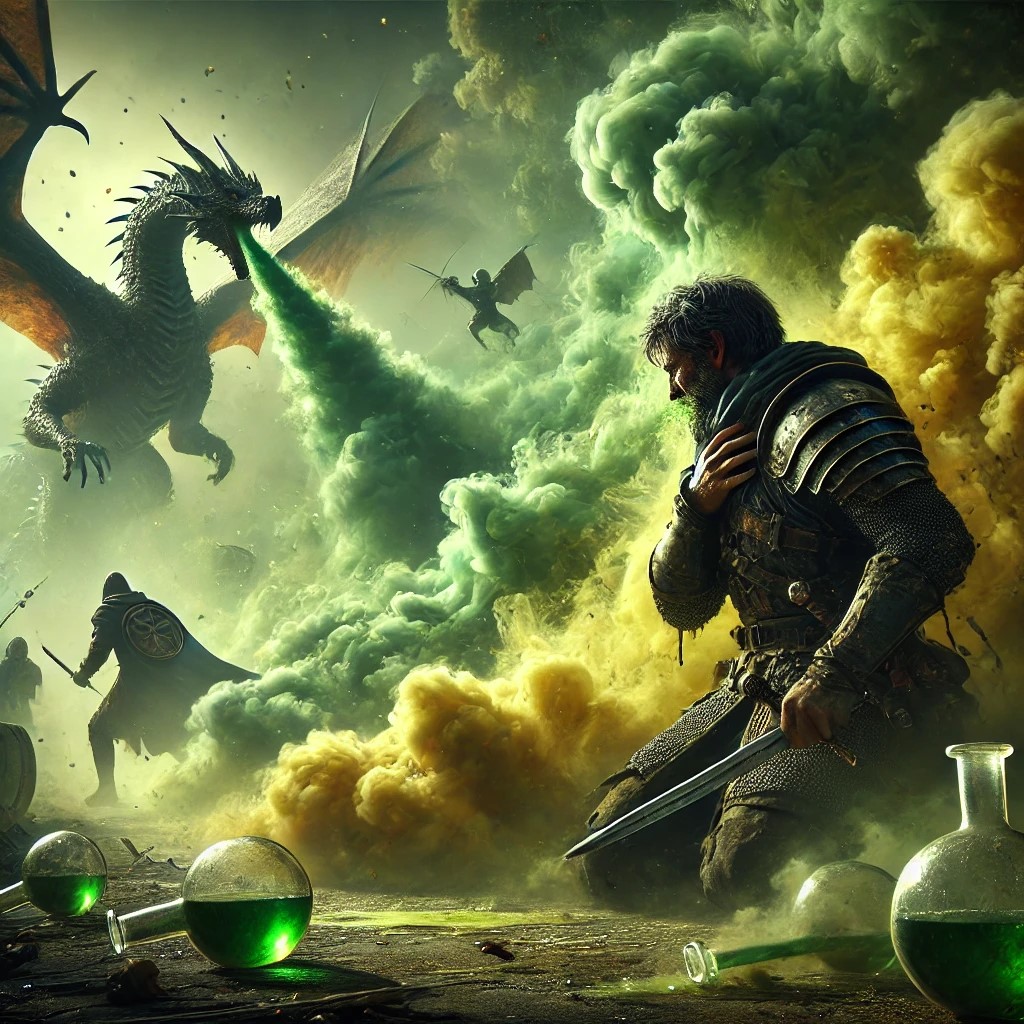Gas-based Attacks
Gas-based attacks are threats that manifest as vapours or invisible atmospheres that harm, incapacitate or otherwise affect targets. These attacks bypass conventional armour and physical barriers, instead working through inhalation, skin contact or simple exposure. The category does not include directional energy attacks such as fire, lightning or frost, though it does encompass steam-like effects. Some attacks originate as breath weapons, such as the chlorine or sleep-inducing gas of dragons, while others stem from spells, alchemical concoctions or environmental hazards. Their effectiveness depends on a target's ability to resist toxins, avoid exposure or mitigate the effects through magical or physical means, making them uniquely dangerous to characters unprepared for such insidious forms of harm. Some traps can also be rigged to release gasses.
When a gas-based attack is triggered, the first consideration is whether the target is exposed. Most gases affect creatures through inhalation, skin contact or general presence in the affected area. A character in an enclosed suit of armour or one who doesn't need to breathe, such as an undead or a golem, may be entirely immune. Spells like water breathing can sometimes provide an unintended benefit against gas attacks by allowing a character to hold their breath indefinitely. However, most living creatures must immediately make a saving throw, typically against poison or breath weapon, depending on the nature of the gas.
Many gasses take the form of expanding clouds, filling rooms, corridors or open spaces. Some remain stationary, while others drift with air currents or magical influence. A strong wind or magical effect like gust of wind can disperse some gaseous attacks, reducing their danger. Conversely, enclosed areas can trap gases, making them more lethal.
Not all gas-based attacks deal damage or injure directly. Natural gases such as black damp (carbon dioxide), inflammable air (natural gas) or rotten vapour (sour gas) create their own, unique problems.
Effects
Determining the effect of a gas attack after exposure depends on the source. Some gases cause immediate harm, such as a green dragon's chlorine breath, which inflicts instant damage. Others, such as sleep gas, do not deal damage but instead incapacitate their victims. Persistent or creeping gases may continue to affect characters every round until they escape or the gas is dispersed. If a gas attack has lingering effects, such as paralysis or poison, additional saving throws may be required to resist further consequences.
Mitigation strategies include magical and mundane means. Spells like neutralise poison and slow poison can counteract the effects of toxic gases, though they often must be applied swiftly. Certain magical items, such as a necklace of adaptation or ring of free action, may provide complete immunity by negating the need to breathe or preventing paralysis. Mundane solutions exist as well — covering one's mouth with a damp cloth may provide limited resistance against inhaled toxins, while a sealed container or mask could offer better protection in specific situations. Some gases, particularly magical ones, defy simple solutions, requiring more specialized countermeasures.
Movement and positioning are often the best defense. Since gas-based attacks typically affect an area, avoiding or escaping the cloud is the most effective response. teleport or dimension door can bypass the danger entirely, while flight or swift movement may allow a character to clear the affected zone before suffering full exposure. However, characters unaware of the gas or unable to react in time may succumb before they can take any preventative measures.
Persistence
Many gas effects linger in an area for multiple rounds; whether magical or mundane, gas dispersal should be adjudicated based on environment and conditions. A still, enclosed space may trap the gas indefinitely, while an open battlefield with wind could cause it to dissipate rapidly. Some spells, such as cloudkill, are specifically designed to drift through an area over time.
Gas attacks behave differently in water and air. While most are ineffective underwater, certain magical gases, especially those created by spells or breath weapons, may persist as bubbles or dissolve into the liquid, affecting creatures in different ways. Enclosed spaces, such as caves or dungeons, may trap gases and force players to consider air supply and escape routes.
Creatures able to Attack with Gas
Monsters known to use gas-based attacks include (partial list):
See also,
Natural Abilities
The Adventure
